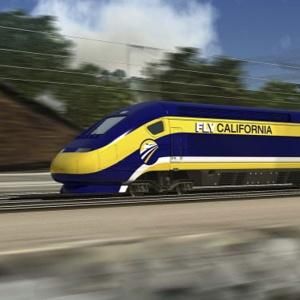Bullet train’s unyielding new foe: Wealthy equestrians
 When the California High-Speed Rail Authority surveyed the landscape and sought to determine the big obstacles to getting the state’s bullet-train project built, some foes were obvious: The Howard Jarvis Taxpayers Association, which led the fight in 2008 against Proposition 1A, the successful ballot measure that gave $9.95 billion in bond seed money for the project. The Legislative Analyst’s Office, which has been skeptical about the legality of the bullet train business plan from its very first analysis. Farmers in the Central Valley who feared losing land to eminent domain.
When the California High-Speed Rail Authority surveyed the landscape and sought to determine the big obstacles to getting the state’s bullet-train project built, some foes were obvious: The Howard Jarvis Taxpayers Association, which led the fight in 2008 against Proposition 1A, the successful ballot measure that gave $9.95 billion in bond seed money for the project. The Legislative Analyst’s Office, which has been skeptical about the legality of the bullet train business plan from its very first analysis. Farmers in the Central Valley who feared losing land to eminent domain.
But it seems safe to say the rail authority didn’t expect implacable, unyielding opposition from this group: Wealthy equestrians. For months, they have targeted plans to put the tracks for high-speed rail in parts of the San Fernando Valley that are beloved by horse owners and riders.
Attempts to reassure the equestrians that the effects would be minimal blew up in the rail authority’s face in March. The authority touted a study from the San Jose State-based Mineta Transportation Institute that said the bullet train would have little effect on horses and riding along the Tujunga Wash and other communities in the Santa Clarita-Sunland area.
Leaders of the equestrian communities in the north San Fernando Valley — home to an estimated 10,000 horses — dismissed the report as untrustworthy because rail authority Chief Executive Jeff Morales and former bullet-train board member Rod Diridon serve on the institute’s board.
Bullet-train board chairman Dan Richard further undermined confidence in rail authority claims at a March public meeting when he noted that in Europe, cows have become used to the noise of passing bullet trains. The comparison of cows to horses — considered an unusually high-strung animal — prompted laughter and disbelief.
‘Environmental justice’ move not paying off
The bullet-train route was changed in ways that outraged equestrians in response to criticism that previously planned routes would bisect working-class, largely Latino communities in more populated parts of the San Fernando Valley. Richard likened this decision to “environmental justice” at the March public meeting. But the route change hasn’t won much praise from opponents of the previous alignment, who still see the bullet train as more trouble than it is worth.
Now rail authority officials find themselves caught in an unexpected crossfire from both wealthy and working-class critics in the San Fernando Valley. A recent Los Angeles Times story treated the rich equestrians’ grievances with the same sympathy that previous coverage had shown for protesters from Pacoima and Sylmar:
Dale Gibson grimly shook his head, his white cowboy hat blocking out the bright afternoon sun.
“How about this mess,” he said, walking through his Sunland ranch in the shadow of the San Gabriel Mountains.
Gibson, a rodeo cowboy and stuntman who has performed in more than five dozen films, was pondering the prospect of 220-mph bullet trains rocketing about 100 feet from his competition arena along the Big Tujunga Wash. He boards about 100 horses on 5 acres and, on many days, is out teaching children and actors the finer points of riding.
“It would be like trying to ride your horse down the runway at LAX,” Gibson said. “We will be done.”
Study seeing minimal effect widely ridiculed
Meanwhile, the Mineta Institute study’s findings continue to draw mockery from equestrians who see it as confirmation that they’re not being taken seriously. The study stated that compared to humans, “horses are somewhat deaf.”
The assertion outrages Gibson who, to prove his point, made a kissing sound to a horse about 50 feet away. The animal raised its head. “Does he look deaf to you?” asked Gibson, who serves on the Los Angeles Equine Advisory Committee.
“Deaf?” he said. “I don’t think so.”
That’s also from the recent Times account.
The only conceivable way to placate both the equestrian community and residents of San Fernando, Sylmar, Pacoima and neighboring towns is to build a 20- to 24-mile segment of the bullet train underground. But given that studies suggest it costs nine times as much to build underground tracks as above-ground tracks, that could balloon the cost of the estimated $64 billion project by at least $20 billion.
The state government presently doesn’t have enough money to complete the project’s initial $21 billion segment in the Central Valley. The prospect it may have to spend far more than expected to bring the bullet train to the Los Angeles region could make it even more difficult to attract the private investors that the rail authority has been hunting for without success since 2008.
Chris Reed
Chris Reed is a regular contributor to Cal Watchdog. Reed is an editorial writer for U-T San Diego. Before joining the U-T in July 2005, he was the opinion-page columns editor and wrote the featured weekly Unspin column for The Orange County Register. Reed was on the national board of the Association of Opinion Page Editors from 2003-2005. From 2000 to 2005, Reed made more than 100 appearances as a featured news analyst on Los Angeles-area National Public Radio affiliate KPCC-FM. From 1990 to 1998, Reed was an editor, metro columnist and film critic at the Inland Valley Daily Bulletin in Ontario. Reed has a political science degree from the University of Hawaii (Hilo campus), where he edited the student newspaper, the Vulcan News, his senior year. He is on Twitter: @chrisreed99.
Related Articles
Iowa might not be so attractive for CA businesses
Feb. 21, 2013 By John Seiler Long Beach still sometimes is called “Iowa Beach” because so many people from that
Arizona whites trust Latinos with concealed guns!
John Seiler: The caricature of Arizona presented by immigration activists, California politicians, and the Obama administration is that Arizona is
Will CA trust SF Bay Bridge re-opening?
After months of controversy over the 36 cracked bolts on the new eastern span of the San Francisco/Oakland Bay Bridge,



